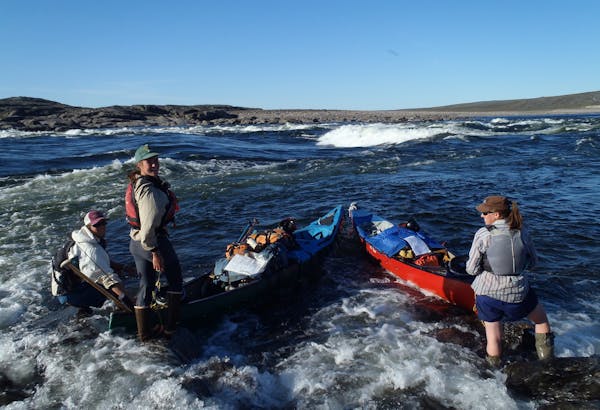Fishing lures are an integral part of Mark Fisher's life. As Rapala's director of field promotions, he can tell you in minute detail about all the lures the company offers. But his voice takes on a softer, less-businesslike tone when he talks about the 1963 version of the Rapala Original Floating Minnow he keeps in his desk drawer at his office in Minnetonka.
"When I was a kid we fished it for the first time on one of those classic Minnesota vacations," he said.
There's a short pause — you can envision him recalling that youthful exuberance and magic that goes along with catching fish — and then it's right back to business.
"So I've got that lure, and I can go out to our test tank and run it next to [today's version of] our No. 9 floater, and that action is much the same," Fisher said.
That's no accident. When, 80 years ago, Lauri Rapala carved from cork the prototype of what would go on to become the first Rapala lure, his goal was to create one that emulated the fish behavior he observed in the clear waters of lakes around his home in Finland. He knew big fish eat smaller fish, of course, but he'd also learned another vital fact: Big fish specifically target smaller fish that are wounded, or that swim in an off-kilter, different fashion from the rest of the school.
While the Original Floating Minnow is Rapala's most popular, the company manufactures lures that dive deep, swim on the surface, and that anglers cast and troll for fish in freshwater and saltwater alike. And while the entity that bears his name may be more than Rapala ever envisioned when he was simply trying to provide for his family, all of the lures that have come since are deeply rooted in his observations of the natural world.
"The construction of the lures back then is not much different from how we build them today," Fisher said. "If anything has been changed over the years — and there have been slight modifications — they have always been to enhance the modern angler of that time."
Anglers' motivation may be similar today to what it was in the 1930s — to feel a fish tugging on the end of the line — but there have been notable advancements in the equipment available to them. Fishing line, for example, is thin but incredibly strong. Some of it doesn't stretch at all, which means the hardware used on lures has to be similarly strong without compromising their intended action.
One of the earliest alterations to Rapala's original lure creations was to hand-carve them from balsa wood, which has a consistent density, and is light and strong. A variety of other fishing lure manufacturers also use balsa, which can be carved or shaped by a wood lathe to create a lure that mimics the subtle swimming movements of a live minnow. With balsa, "You are going to get a lot of light action carried through the lure," Fisher said.
Lure creation
When Lauri Rapala began carving, he didn't have modern lathes and precision equipment available to him. (The company today makes its own equipment to ensure consistency among its lures.) Nor did he have a large team of expert anglers and fishing aficionados with whom to share and discuss ideas. And buying lures at the store was out of the question.
"Every village had a guy who was a notable lure designer," Fisher said. "Maybe one guy carved a shape that was a little different. These guys all talked to each other. Lauri would get together with one of his best friends, and they would compare notes — what if we modified this or that? By today's modern standards, they were fish heads. They didn't have the luxury of going and buying and securing lures. They basically made them, and that's literally how they carved out their niche."
Fisher today is intimately involved in creating Rapala's new lures, and modifying existing ones to fit modern fishing tackle and equipment. But unlike Lauri Rapala in the early days, Fisher works with a whole design and development team — here and at the Rapala factory in Finland — as well as anglers who make their living by catching fish. There are discussions about lures, and conceptual drawings are made for a subset of those. Simple wooden models are created of the ones that show particular promise, to determine if the idea really has merit. A few ideas, then, move into the testing phase, which generally lasts more than a year and potentially includes the creation of 50 to 100 prototypes.
"You start out with the shape," Fisher said. "If something has great eye appeal, you are on the right trail. Cosmetics and aesthetics are just as important for us as the action of a lure. If it looks good, it's going to make anglers feel good about casting or trolling it."
Indeed, each Rapala lure receives a dozen or more coats of paint and lacquer to create an exact look. Then, each lure is hand-tested to ensure it looks and swims right in the water. That's a practice that came directly from the founder himself, who was a stickler for ensuring every lure had the proper action.
"Our whole company is predicated on trying to make [lures mimic] the classic injured minnow," Fisher said. "That has been the case since 1936, when Lauri was just trying to catch a pike."
Joe Albert is a freelance writer from Bloomington. Reach him at writerjoealbert@gmail.com.
Kucherov is 5th player in NHL to reach 100 assists as Lighting beat Matthews, Maple Leafs 6-4
Grateful for the beast that is the Boston Marathon

Joel Embiid scores 23 points, has the big assist as 76ers beat Heat in play-in to earn No. 7 seed

